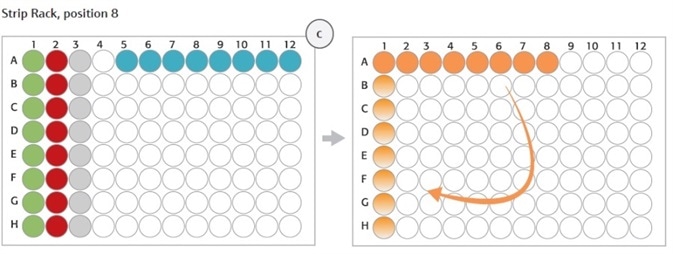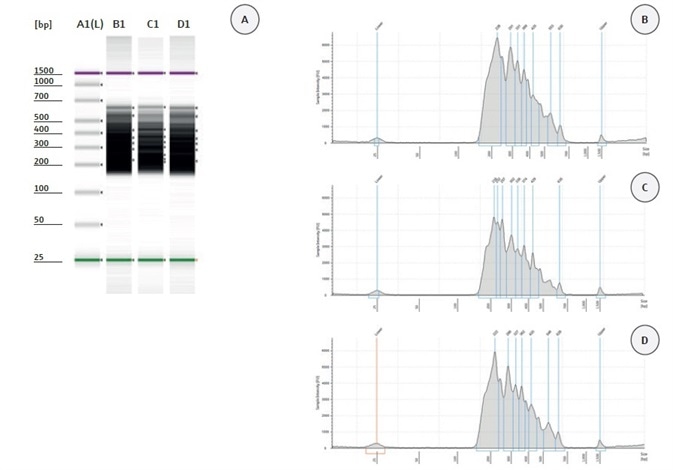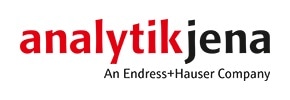Automating the preparation of libraries is extremely useful in reducing opportunities for error, increasing reproducibility, and reducing the hands-on time required for researchers to efficiently generate sequence data from DNA.
The CyBio® FeliX is a benchtop instrument suitable for a variety of automated liquid handling tasks. It has been possible to automate the HaloPlex Target Enrichment System Kit for NGS library preparation for Ion Torrent™ Sequencing, achieving reliable final prepared libraries that are accurate enough for downstream sequencing.
This article outlines a successful proof of principle for the generation of high-quality DNA libraries by using the CyBio® FeliX for personal genome analysis in conjunction with the Ion Torrent™ Sequencing System.
The CyBio® FeliX is a compact, flexible liquid handling platform that has 12 deck positions over two levels, suitable for tube racks, microplates, reservoirs, and tips in a small footprint. It also includes accessories such as a magnet adapter, gripper, and thermal shaker.
Library preparation is a vital, manual, and often time-consuming stage of the Next Generation Sequencing (NGS) workflow. Analytik Jena developed a protocol designed to simplify the NGS library preparation process; a process that uses the HaloPlex Target Enrichment System Kit with minimum user intervention to prepare eight library samples for multiplexed sequencing on the Ion Torrent™ platform.
The Institute for Laboratory Medicine, based in the Donauspital in Vienna has evaluated the CyBio® FeliX liquid handling platform, using this to prepare DNA sample libraries from patient samples. Target enrichment of genomes was found to significantly enhance the efficiency of Next Generation Sequencing, meaning that researchers can focus on specific regions of interest more easily.
The Kit is ideal for the deep sequencing of small panels of genes (up to 2.5 Mb), for example, those necessary for studies of cancer, inherited disorders, or infectious and neurologic diseases.
Materials and methods
Consumables
- Hardshell 96-well PCR plate (Eppendorf twin.tec, skirted, 0030 128.680)
- 8-well PCR strip tubes with caps (Nippon Genetics p/n FG-088WF)
- Skirted 0.5 ml tubes (STARLAB, E1405-2120)
- 2 ml tubes (STARLAB, E1420-2340)
- Tube Caps (STARLAB, 1480-0199)
- CyBio® TipBox 96/50 μl (OL 3811-25-535-N)
- CyBio® TipBox 96/250 μl (OL 3811-25-637-S)
- Qubit assay tubes (Life Technologies p/n Q32856)
Kits and Reagents
Library preparation for Ion Torrent™ Sequencing was undertaken with eight normalized patient DNA samples (225 ng). These were isolated using the innuPREP Blood DNA Mini Kit from Analytik Jena AG.
A Qubit fluorometer from Life Technologies was used to quantify patient DNA, and an individual target-enriched, the barcoded library was prepared for each sample of patient DNA to be sequenced. The HaloPlex probes used were designed using Agilent´s SureDesign tool.
- HaloPlex Target Enrichment System Kit (Agilent)
- HaloPlex Custom Panel Tier 1, ION (G9902B)
- Herculase II Fusion Enzyme with dNTPs (100 mM; 25 mM for each nucleotide) (Agilent p/n 600677)
- Agencourt AMPure XP Kit 5 ml / 60 ml (Beckman Coulter Genomics p/n A63880, p/n A63881)
- Nuclease-free Water (not DEPC-treated) (Ambion Cat #AM9930)
- 10 M NaOH, molecular biology grade (Sigma, p/n 72068)
- 10 mM Tris-EDTA, pH 8.0
- 2 M acetic acid (Sigma, p/n 72068)
- InnuPREP Blood DNA Mini Kit (Analytik Jena AG, 845-KS-1020050)
- Quant-iT dsDNA BR Assay Kit, used with the Qubit fluorometer (100 assays, 2-1000 ng, 500 assays, 2-1000 ng) (Life Technologies p/n Q32850, Life Technologies p/n Q32853)
- 100% Ethanol, molecular biology grade (Sigma-Aldrich p/n E7023)
Consumables
- Hard shell 96-well PCR plate (Eppendorf twin.tec, skirted, 0030 128.680)
- 8-well PCR strip tubes with caps (Nippon Genetics p/n FG-088WF)
- 2 ml tubes (STARLAB, E1420-2340)
- Skirted 0.5 ml tubes (STARLAB, E1405-2120)
- Tube Caps (STARLAB, 1480-0199)
- CyBio® TipBox 96/50 µl (OL 3811-25-535-N)
- CyBio® TipBox 96/250 µl (OL 3811-25-637-S)
- Qubit assay tubes (Life Technologies p/n Q32856)
Equipment
- CyBio® FeliX Head R 96/250 μl (OL3316-14-850)
- CyBio® FeliX (OL 5015-24-100) with CyBio® Composer Software
- 12-channel adapter Head R 96 (OL 3317-11-340)
- 8-channel adapter Head R 96 (OL 3317-11-330)
- Tube Rack 2.0 ml for 24 tubes (844-00136-0)
- Gripper (OL 3317-11-800)
- Magnet Adapter M96 (Biovendis, 209601)
- IsoFreeze PCR Rack SBS (LTF0045)
- BioShake 3000-T elm with PCR plate adapter (QInstruments, 1808-0517)
- Waste box (844-00430-0)
- Mounting Kit BioShake 3000 Series (OL 3317-23-690)
- Reagent tube Support (OL 3317-11-240) with Reagent tube 30 ml (2320230-00)
- Thermal cycler 2200 TapeStation (Agilent p/n G2964AA or G2965AA)
- High Sensitivity D1000 Reagents (Agilent p/n 5067-5585)
- High Sensitivity D1000 ScreenTape (Agilent p/n 5067-5584)
- Qubit 2.0 Fluorometer (Life Technologies p/n Q32866)
- Mounting Kit BioShake 3000 Series (OL 3317-23-690)
- Ion PGM sequencer (Life Technologies)
-2.jpg)
Figure 1. CyBio® FeliX Liquid Handling Platform. The two-level deck design of the CyBio® FeliX possesses a small footprint while providing sufficient deck positions for reagents, accessories and consumables.
Experimental Design and Analysis
The CyBio® FeliX platform was used to perform automated library preparation. The method’s automation followed the HaloPlex Target Enrichment System Kit protocol (Agilent) with some minor modifications.
During this process, the tubes and PCR plate were not centrifuged or cooled. The Enzyme Reaction Strips on position 8 of the deck layout (Day 1), however, were placed on a precooled PCR rack. Short incubations were performed on deck, with the PCR plate unsealed during these.
Figure 2 gives an overview of the automation workflow. The method features several stop points that are recommended in the protocol for manual steps.
Table 1. Workflow of the Agilent HaloPlex Target Enrichment System on CyBio® FeliX. Gray steps can be performed on CyBio® FeliX with minimal user intervention (add on magnetic particles). White steps are performed off-deck using additional equipment. Source: Analytik Jena US
| . |
| Day 1 |
Step 1 |
Digest genomic DNA
with restriction enzymes |
→ |
Manually: sample preparation*
Optional: Validation of digestion |
| Step 2 |
Hybridize digested DNA
to HaloPlex probe for target
enrichment & sample barcoding |
→ |
Extern: PCR cycler* |
| Day 2 |
Step 3 |
Capture to target DNA |
→ |
Manually: Magnetic beads preparation** |
| Step 4 |
Ligate the captured, circulated fragments |
| Step 5 |
Prepare the PCR Mastermix |
| Step 6 |
Elute the captured DNA with NaOH |
| Step 7 |
PCR amplify the captured target libraries |
→ |
Extern: PCR cycler* |
| Step 8 |
Purify the amplified target libraries |
→ |
Manually: Magnetic beads preparation** |
| Step 9 |
Validate enrichment & qualify enriched target DNA |
→ |
Extern: 2200 TapeStation (Agilent) |
| Step 10 |
Pool samples with differnet barcodes for multiplexed sequencing |
→ |
Manually |
*Automation possible;
**Automation possible, but for optimal results we recommended to add beads manually under optical control
Figure 2 shows the deck layout for the 2-day protocol. This deck layout was changed to column by column and row wise distribution for digestion and hybridization on day 1, and for magnetic bead-based capture and purification on day 2.

Figure 2. (A) Deck layout day 1 (protocol step 1 – 2) and (B) deck layout day 2 protocol step 3 – 8) of the CyBio® FeliX platform using Agilent HaloPlex Target Enrichment System Kit. Image Credit: Analytik Jena US
To properly evaluate the automated procedure, the CyBio® FeliX workstation was used to prepare a total of eight patient DNA sample libraries (with no internal control).
During the automated library preparation protocol, both bead solutions for capturing target DNA (HaloPlex Magnetic Beads) and purification amplified target libraries (Agencourt AMPure XP beads) were manually prepared and added.
Manual bead preparation was necessary to avoid bead clumping, leading to improved homogeneous suspension and more uniform distribution of beads on the PCR plate.
PCR library amplification was conducted off-deck, with amplified (sequencing ready) libraries, then analyzed and quantified via a High Sensitivity D1000 ScreenTape with D1000 Reagents (both Agilent) for the Agilent 2200 TapeStation.
Detailed protocol - library preparation
Comprehensive guidelines around the construction of libraries using the HaloPlex Target Enrichment System Kit for Ion Torrent™ Sequencing on the CyBio® FeliX follow.
These protocols include volumes appropriate for eight samples with two reaction excess. This protocol workflow has two different deck layouts and is spread over 2 days due to the need for a 16-hour hybridization step.
Step 1 - Digest genomic DNA with restriction enzymes
First, normalized genomic DNA (gDNA) samples were prepared, manually diluted and supplied in an 8-well strip (Figure 2C, blue tube strip).
Restriction Enzyme Master Mix was also prepared before the digestion process was conducted on the thermal shaker (BioShake 3000 T elm) on deck. The Agilent 2200 TapeStation was used to validate the restriction digestion reaction.
Step 2 - Hybridize digested DNA to HaloPlex probe for target enrichment and sample barcoding
The HaloPlex probe was designed to selectively hybridize to target regions of the genome. The 8-well strips from step 1 (Enzyme Strips, RE-Mastermix Strip) on position 8 (columns 1-3) were discarded manually before being replaced with a new 8-well strip for the Hybridization Master Mix (Figure 2C, orange tube strip).
Digested DNA samples from the 96-well Restriction Digest Reaction Plate were then pooled with the 12-channel adapter in the hybridization reaction strip. Following DNA pooling, this hybridization reaction strip had to be rotated manually before the HaloPlex ION Barcode Primer Cassette was added to each tube with an 8-channel liquid handling adapter (Figure 2C).
This hybridization step was performed overnight, conducted externally in a thermal cycler using an appropriate thermal cycler program (Table 1).
Step 3 - Capture the target DNA
Streptavidin-coated magnetic beads that had been resuspended and prepared were provided and transferred – this was all done manually. To ensure optimal results, it is recommended that beads are added under optical control, allowing a homogenous bead suspension to be distributed to all samples. Each of the mixing and washing steps summarized below were performed automatically.
Step 4 - Ligate the captured, circularized fragments
Ligation Master Mix was prepared and then added to the DNA captured reactions. This was then incubated in the on-deck thermal shaker.
Step 5 - Prepare the PCR Master Mix
A PCR Master Mix was prepared for the captured target DNA amplification step before being distributed to 0.2 ml 8-well strip.
Step 6 - Elute captured DNA with NaOH
Following the ligation reaction, captured DNA libraries were eluted with freshly prepared 50 mM NaOH.
Step 7 - PCR amplify the captured target libraries
An external thermal cycler was used to amplify libraries within the PCR Master Mix prepared in step 5. Cycling was also performed externally using a thermal cycler with parameters in Table 2.
Step 8 - Purify the amplified target libraries
AMPure XP beads were used to purify amplified DNA. These beads were prepared manually in line with the protocol before being added manually to the samples as per step 3. Amplified libraries were eluted in 10 mM Tris-EDTA before being transferred into a new column of the process plate in position 9.
Step 9 - Validate enrichment and quantify enriched target DNA
The final libraries’ size distribution was externally verified using a 2200 TapeStation (Agilent). Size distribution of libraries should ideally be between 150 and 550 bp.
Step 10 - Pool samples with different barcodes for multiplexed sequencing
This step was also performed manually, in line with recommendations from the Agilent protocol.
Table 2. Probe hybridization PCR program for HaloPlex Target Enrichment for Ion Torrent™ Sequencing. Source: Analytik Jena US
| Step |
Temperature |
Holding time |
| 1 |
95 °C |
10 min |
| 2 |
54 °C |
16 hours/overnight |
Table 3. Post-capture DNA amplification PCR program for HaloPlex Target Enrichment for Ion Torrent™ Sequencing. Source: Analytik Jena US
| Step |
Cycle |
Temperature |
Holding time |
| 1 |
1 |
98 °C |
2 min |
| 2 |
16 (cycle number
varies for each
HaloPlex Probe design) |
98 °C |
30 sec |
| 60 °C |
30 sec |
| 72 °C |
1 min |
| 3 |
1 |
72 °C |
10 min |
| 4 |
1 |
8 °C |
hold |
Results and discussion
A total of eight patient samples were utilized for automated library construction using the CyBio® FeliX platform and a HaloPlex Target Enrichment System Kit. To efficiently assess library quality, the validation of enriched target DNA was analyzed with the 2200 TapeStation (Agilent), in line with the manufacturer´s instructions.
If the library had been properly constructed with adapters and barcodes to both ends of the fragment, an electropherogram should show a peak fragment size of between 150 to 550 bp. Figure 3 shows TapeStation data obtained from the analysis of 2 µl of each amplified library.
Figure 3A displays the gel image for three selected amplified libraries (patient sample 115 - 117). All of the samples prepared with the the CyBio® FeliX and HaloPlex Target Enrichment System Kit were found to be consistent and with the required fragment size distribution - a peak between 200 and 550 bp (Figure 3, B – D).

Figure 3. (C) Strip rack layout (position 8, deck layout day 1): After digestion of gDNA (step 1) Enzyme Strips (red and green), RE-Mastermix Strip (grey) and DNA template Strip (blue) are discarded and replaced by Hybridization Strip (orange). For hybridization DNA samples were pooled in Hybridization Strip (orange). The Strip was rotated manually (light orange) before adding the HaloPlex ION Barcode Primer Cassette. Sample concentrations measured by the TapeStation were approximately equal: 150.6 nmol/l for patient sample 115, 128.1 nmol/l for patient sample 116 and 126.3 nmol/l for patient sample 117. Image Credit: Analytik Jena US
Yield rates were found to be very good, with only 100 pmol/l required for the sequencing process. Overall, this data demonstrates the potential of the the CyBio® FeliX for automated NGS library preparation.

Figure 4. Validation of HaloPlex enrichment by 2200 TapeStation analysis. (A) Gel Image of 3 analysed samples. Lane A1: High Sensitivity Ladder, Lane B1: patient sample 115, Lane C1: patient sample 116, Lane D1: patient sample 117. Electropherograms (B-D): patient sample 115 (B), patient sample 116 (C), patient sample 117 (D). Image Credit: Analytik Jena US
Conclusion
Using a combination of the CyBio® FeliX and the HaloPlex Target Enrichment System Kit for Ion Torrent™ Sequencing, automated library sample preparation for Ion Torrent™ Sequencing can be successfully performed.
While the HaloPlex Target Enrichment System protocol from Agilent for Illumina Sequencing includes identical steps, the quality of libraries automatically prepared on the CyBio® FeliX was equivalent to those prepared manually.
Use the CyBio® FeliX for automated NGS sample preparation via the HaloPlex Target Enrichment System Kit can facilitate the straightforward preparation of multiple samples with excellent consistency and minimal effort.
Overall, the CyBio® FeliX offers an ideal means of flexible liquid handling, helping improve reproducibility of results while reducing hands-on time.
About Analytik Jena US
Analytik Jena is a provider of instruments and products in the areas of analytical measuring technology and life science. Its portfolio includes the most modern analytical technology and complete systems for bioanalytical applications in the life science area.
Comprehensive laboratory software management and information systems (LIMS), service offerings, as well as device-specific consumables and disposables, such as reagents or plastic articles, complete the Group’s extensive range of products.
About life science
The Life Science product area demonstrates the biotechnological competence of Analytik Jena AG. We provide a wide product spectrum for automated total, as well as individual solutions for molecular diagnostics. Our products are focused to offer you a quality and the reproducibility of your laboratory results.
This will surely ease your daily work and speed up your work processes in a certain way. All together we support you through the complete process of the lab work. Besides we offer customized solutions and are able to adapt our products to your needs. Automated high-throughput screening systems for the pharmaceutical sector are also part of this segment’s extensive portfolio.
About analytical instrumentation
Analytik Jena has a long tradition in developing high-performance precision analytical systems which dates back to the inventions made by Ernst Abbe and Carl Zeiss. We have grown to become one of the most innovative manufacturers of analytical measuring technology worldwide.
Our business unit Analytical Instrumentation offers excellent competencies in the fields of optical spectroscopy, sum parameters and elemental analysis. Being proud of our core competency we grant all our customers a long-term warranty of 10 years for our high-performance optics.
About lab automation
With more than 25 years of market experience, Analytik Jena with its CyBio® Product Line is a leading provider for high quality liquid handling and automation technologies. In the pharmaceutical and life science industries, our products enjoy the highest reputation for precision, reliability, robustness and simplicity.
Moreover, the Automation Team designs, produces and installs fully automated systems tailored to our clients' application, throughput and capacity requirements. From stand-alone CyBio® Well up to fully customized robotic systems we handle your compounds, biomolecules and cells with great care.
Sponsored Content Policy: News-Medical.net publishes articles and related content that may be derived from sources where we have existing commercial relationships, provided such content adds value to the core editorial ethos of News-Medical.Net which is to educate and inform site visitors interested in medical research, science, medical devices and treatments.